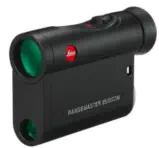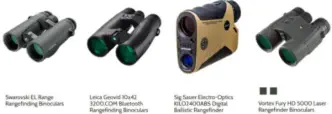LASER RANGEFINDERS
Best Hunting Laser Rangefinders
Laser rangefinders are a must have for hunting. They will tell you in an instant exactly how far away your target is, which is very important for bow hunting, to be able to quickly know which sight pin to use. They are important for rifle hunting, to tell you how far up or down you need to place your shot in order to hit the vital organs. Rangefinders operate by firing an invisible, tightly focused, beam of light at a given target and then measuring the time it takes for that beam of light to be reflected from the target and returned to the rangefinder. This calculates the distance to the target.Leica Rangemaster CRF 3500.COM Rangefinder
The Leica® Rangemaster™ CRF 3500.COM Laser Rangefinder is probably the last rangefinder that you will ever need. It is a compact, high tech ballistic powerhouse, complete with Bluetooth® technology. This rangefinder has a class 3R laser that is capable of providing precise and reliable range finding measurements at distances up to 3,500 yards. It will work in any environment, in fractions of a second. Using it’s built in Bluetooth functionality, the Leica Rangemaster syncs with the Kestrel Elite weather meter for applied ballistics technology. It can also sync with your Apple Watch so that you can easily and quietly send data between spotter and shooter. It is also weatherproof. This rangefinder enables you to create individual ballistic profiles in real time, managed through the Leica hunting smartphone app.How To Choose The Right Rangefinder
Determining how you are going to use your laser rangefinder will help you in selecting which one is the best one for you. If you don’t use the advanced features of the high end laser rangefinders, you may not want to buy the higher end ones. But, keep in mind, as for any optics, the more you spend the better the quality and clarity. If you buy one with advanced features that you won’t use, you will use those features at some point because they are there. There are serveral different types of rangefinders.Types of Rangefinders
• Hunting • Surveying • GolfLaser Rangefinder Priority Differences - Which One To Use and When
• Laser Rangefinder First Priority Mode • Laser Rangefinder Second Priority ModeLaser Rangefinder First or Second Priority Mode
When a rangefinder reads the first object in its view, and ignores further away objects, it is said to be in a first priority mode. The opposite is also true. When it ignores the first object, and sees a further away object, is said to be in a second priority mode.Laser Rangefinder First Priority Mode
First priority rangefinders are useful on the golf course, when there is nothing between you and the flag at the next hole. For this reason, all golfing rangefinders are in the first priority mode. This way if you want to range on the flag at the hole between the tree line and you, it will range on the flag, and not the tree line behind it.Laser Rangefinder Second Priority Mode
Second priority rangefinders are useful for hunting. A second priority rangefinder, if you refer to the example above, would read the trees at and ignore the flag that is many yards closer. This makes sense because if you take a hunting use case, and are sitting in your stand, pull up your rangefinder, and if there are branches between you and the deer it will skip those and measure the deer that is futher out to give you the accurate range for the deer. In a hunting situation you want your laser rangefinder to ignore the first object in its line of view such as the branches, and read the most distant object, which may be a deer, elk, or other game animal that you are hunting.Can You Use First Priority Mode Laser Rangefinders For Hunting?
Yes, you can use first prioirty mode laser rangefinders for hunting. Even though you should use second priority mode rangefinders for hunting, as it will work more accurately for you. But, you can always make due with something you already have, if you have already purchased one. Check out your model though, you may have a temporary pinpoint button that will let you switch from second priority to first prioirty temporarily.Rangefinder Qualities To Look For
• Maximum Distance • Reticles and Aiming PointsRangefinding Maximum Distance
Rangefinders will specifically state the maximum readable distance that each unit is capable of. Don’t buy a lower rated one if it is cheaper, as you really are not getting the maximum distance that is listed, as this number is really about ideal atmospheric condtions on large reflective surfaces. Always get one that is rated for a further distance than you need, just to make sure you have what you need when you need it.Rangefinder Reticles and Aiming Points
A reticle of a rangefinder is the crosshair that you see when you look through the rangefinder. Some of these reticles are made of black lines that you line up over the object you want to range. These are difficult to use if you are looking into a dark background, or in low light conditions. Other reticles appear illuminated because they are actually LED lights that are adjustable for how bright that you would like them to be. You could have a problem with these in bright light situations because the lights would be drowned out by the bright light of the sun or reflection. I prefer the lighted ones myself, but some models have a button for backlighting that lets you view your information in all light conditions. It’s a personal choice really. Some people feel that the lighted ones make their eyes adjust to the lighting, and if you are in the shadows or as the sun starts to set, it may affect how your eyes adjust to the dim lighting.Laser Rangefinders and Rangefinding Binoculars
• Swarovski EL Range Rangefinding Binoculars • Leica Geovid 10x42 Bluetooth Rangefinding Binoculars • Sig Sauer Electro Optics KILO 2400 ABS digital Ballistic • Rangefinder Vortex Fury HD 5000 Laser Rangefinder About The Author Mike Mendenhall is the the founder of Mendenhall Outdoors. This website is an extension of the Mendenhall family’s lifestyle and passion for the great outdoors. Everything that they learn, and experience, along the way that they find may be valuable to our website visitors is on the site for you to enjoy. We highlight products and services that you might find interesting. We frequently receive free products from manufacturers to test. This does not drive our decision as to whether or not a product is featured or recommended. If you click a link on this page, then go on to make a purchase, we might receive a commission – at no extra cost to you, and does not impact the purchase price of any products that you may purchase. The Best Laser Rangefinders Experience Awaits!


Website Designed By Mendenhall Family Enterprises
MENDENHALL OUTDOORS © 2025
Privacy Policy
copyright






















